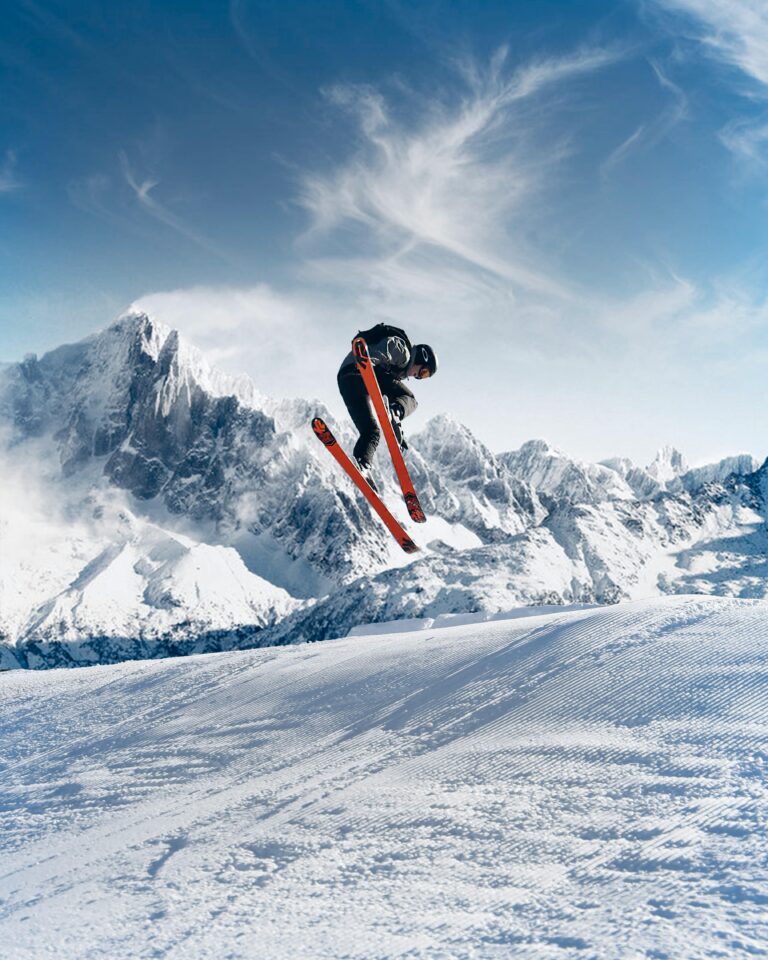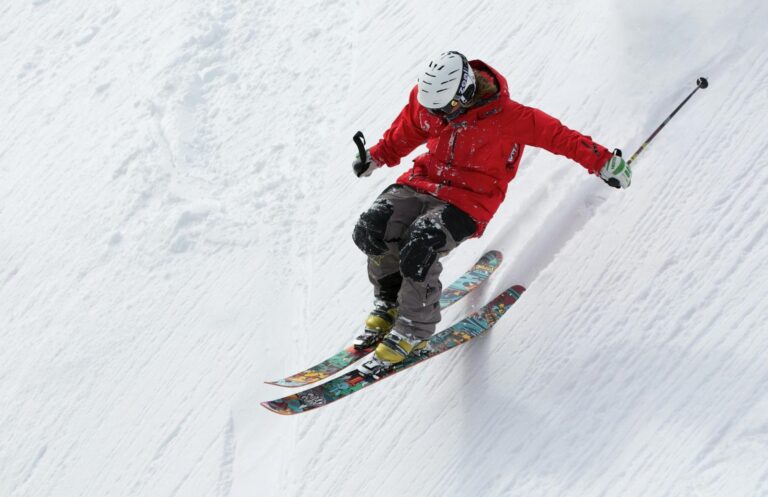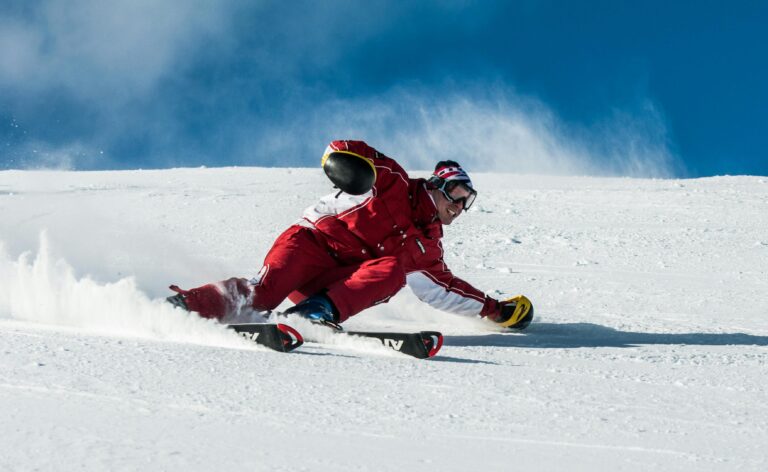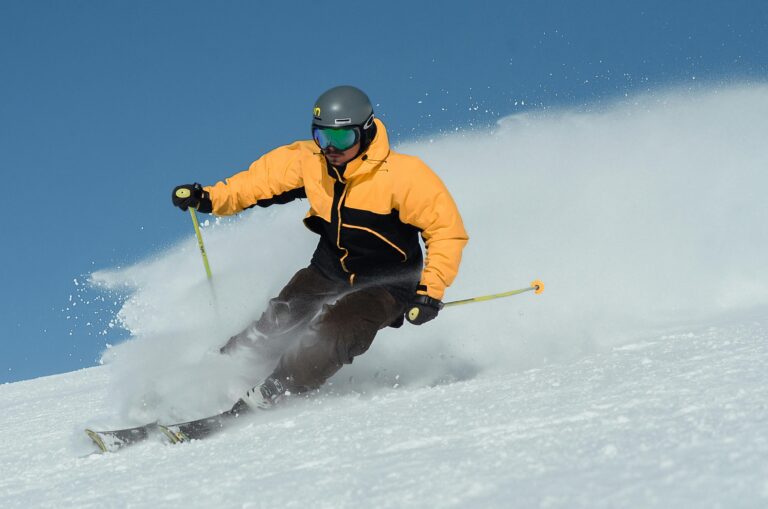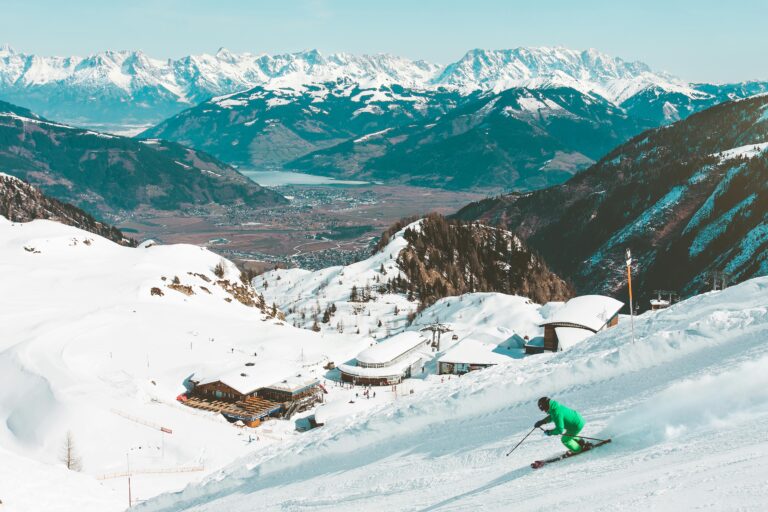Ever found yourself racing downhill, heart pounding, and thinking, “Okay, how do I stop before I hit something?” I’ve been there. Learning to stop on skis isn’t just a safety thing—it’s the secret to feeling in control and actually enjoying your time on the slopes. If you want to ditch those panicked, flailing moments and ski with confidence, stick with me. I’m going to break down five straightforward ways to stop, whether you’re cruising a calm green run or dealing with icy patches.
Steps to Stop on Skis
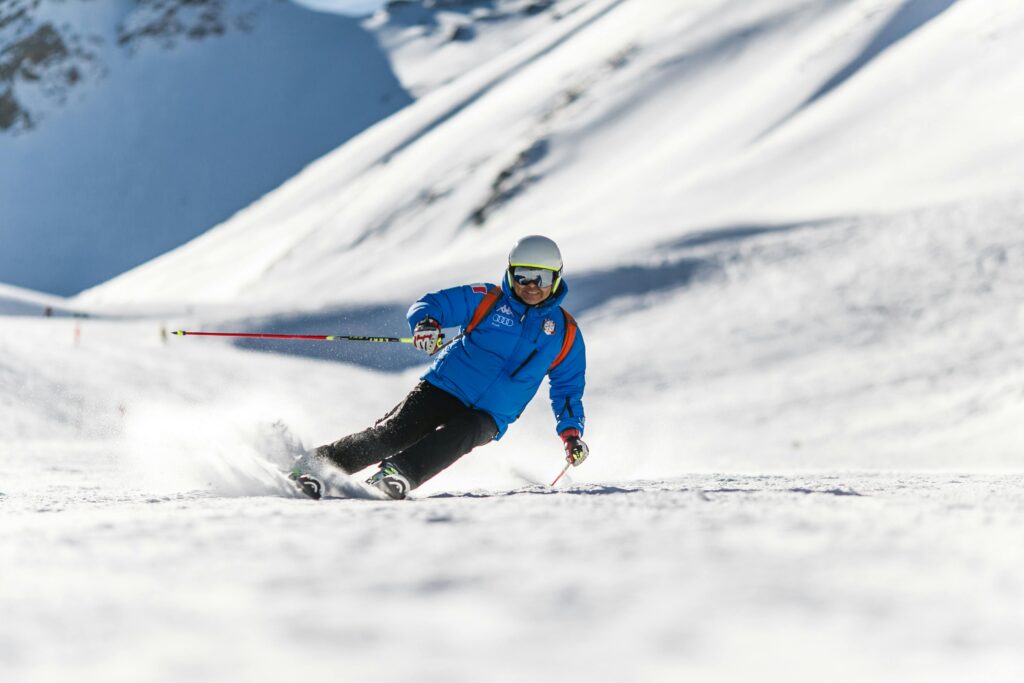
- Assume the Position: Start by standing in a wedge shape, with your heels wide apart and toes together—think of a pizza slice.
- Start Gliding: As you ski, keep your skis in that wedge. It will help you manage your speed.
- Control Your Speed:
- To speed up, move your heels closer together.
- To slow down or stop, push your heels apart.
- Maintain Balance: If you’re getting tired, shift your weight between your skis to stay in control.
Here’s a quick tip: practice this wedge shape on easy slopes early on. Sometimes beginners wait too long to get into their snowplow, and suddenly it’s a struggle to control speed. The faster you get into position, the smoother your ride will be.
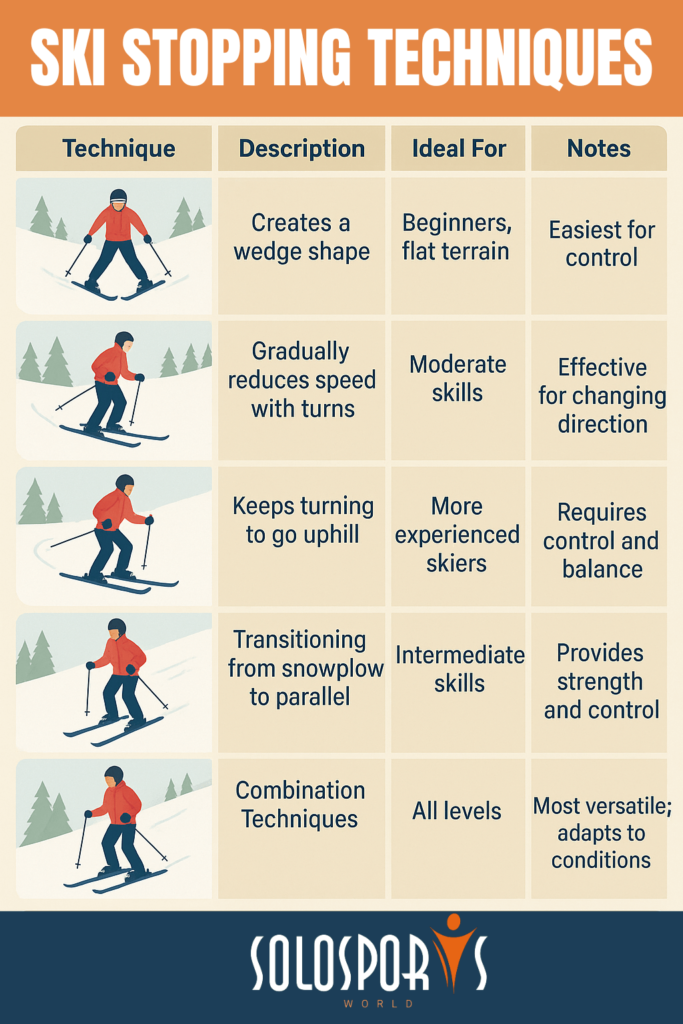
Why Stopping Matters More Than You Think
Stopping on skis isn’t just about avoiding a wipeout. It’s about being safe for yourself and everyone around you. The National Ski Areas Association points out that many injuries happen when skiers can’t slow down or steer properly. Master stopping, and you’ll cut down risks, sail through crowdier runs, and handle rough terrain without breaking a sweat.
Table: Quick Comparison of Stopping Techniques
| Technique | Updated Description | Best Used On | Skill Level | Pro Tip |
|---|---|---|---|---|
| Snowplough Stop | Classic beginner move where ski tips point together to form a wedge, slowing you down steadily. | Gentle slopes, busy beginner areas | New skiers | Keep equal weight on both skis to avoid drifting sideways. |
| C-Shaped Turns | Smooth, arcing turns that naturally reduce speed and help steer around obstacles. | Wide open runs | Low-intermediate | Focus on turning your whole body, not just your legs. |
| Continuous Turns | Linked turns that carry you slightly uphill to bleed off speed, excellent on steeper slopes. | Intermediate trails | Intermediate to advanced | Look ahead to plan your next turn early, not at your skis. |
| Parallel Position | Transitioning from wedge to parallel skis for more controlled and efficient stopping. | Varied terrain | Intermediate | Keep knees soft and ankles flexible to maintain balance. |
| Combination Techniques | Blending various stopping styles based on terrain and snow conditions. | Mixed or changing conditions | All levels | Practice each method individually first, then combine confidently. |
the SNOWPLOUGH Stop: BEST for BEGINNERS & Effective Speed Control
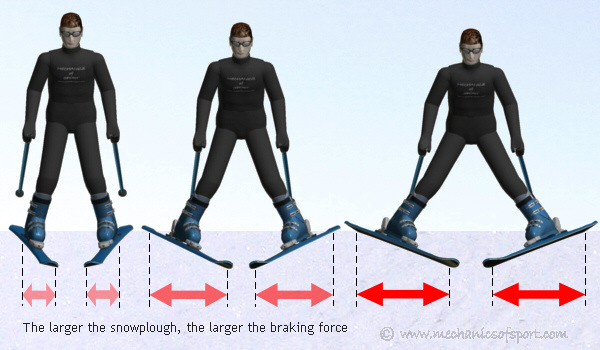
The snowplow stop is your go-to move if you’re just starting out. It’s straightforward and gives you solid control over your speed.
Here’s how you do it:
- Assume the Position: Stand still and shape your skis into a wedge, like a pizza slice—heels apart, toes pointed in.
- Start Gliding: Keep that wedge as you move. Your heels push outward, toes together.
- Control Your Speed: Bring your heels closer to speed up. To slow or stop, push your heels wider apart.
- Maintain Balance: Tired legs? Shift your weight side to side while keeping your wedge. This takes some pressure off one leg without losing control.
A mistake I made starting out was hesitating to wedge early. Once I got into it right after pushing off, slowing down felt way easier. Trust me, starting with the snowplow on gentle slopes will do wonders.
As one beginner shared on reddit “I learned that getting into a snowplow early prevented me from gaining too much speed,”.
C-Shaped Turns: A Fun Way to Slow Down
If you want to mix things up and have a bit of fun while controlling your speed, C-shaped turns are the way to go.
Here’s the basics:
- Position Your Skis: Stand balanced with your skis parallel, feet about shoulder-width apart.
- Initiate a Turn: Shift your weight onto one ski (let’s say your left), gently steer it into a curve that looks like a ‘C’ as you glide.
- Guide the Turn: Smoothly follow through with the turn and notice your speed dropping naturally.
- Complete the Turn: Keep turning until you start moving uphill, bringing yourself to a full stop.
Practicing these turns not only helps dial down your speed but also builds your overall skiing confidence. It feels great to know you’re steering instead of just sliding.
I remember a new skier saying, “I had no idea turning into the “C” would give me that much control — it felt so much smoother!”
Continuous Turns for Speed Management
Feel like you’re ready to step things up? Continuous turns let you keep your speed in check and steer with style.
Try this:
- Start with a Turn: Glide and begin turning right away.
- Extend the Turn: Let your turn flow, switching skis downhill and uphill as you go.
- Build Pressure: Lean into the downhill ski and move your upper body with the turn to stay balanced.
- Uphill Plow: As you turn, guide your skis uphill to slow yourself down, eventually stopping.
This takes some finesse, but hitting that sweet spot where balance and control sync feels awesome.
Parallel Position Transition: A Step Towards Mastery
Once you’re comfortable with your stops, shifting from a snowplow to parallel skis can boost your agility and control, especially on faster runs.
Steps to try:
- Begin in Snowplow: Start your run in the wedge.
- Shift Your Weight: Gradually lean into your downhill ski and bring your uphill ski parallel.
- Speed Control: Use the parallel stance to manage speed while staying balanced.
- Stop When Ready: Lean into turns until both skis are parallel to stop smoothly.
This transition prepares you for steeper, more challenging terrain.
An experienced skier once told me, ‘The parallel position feels so much stronger and more stable than the snowplow.’
Hockey Stop – Best for Narrow Trails & to Stop Quickly
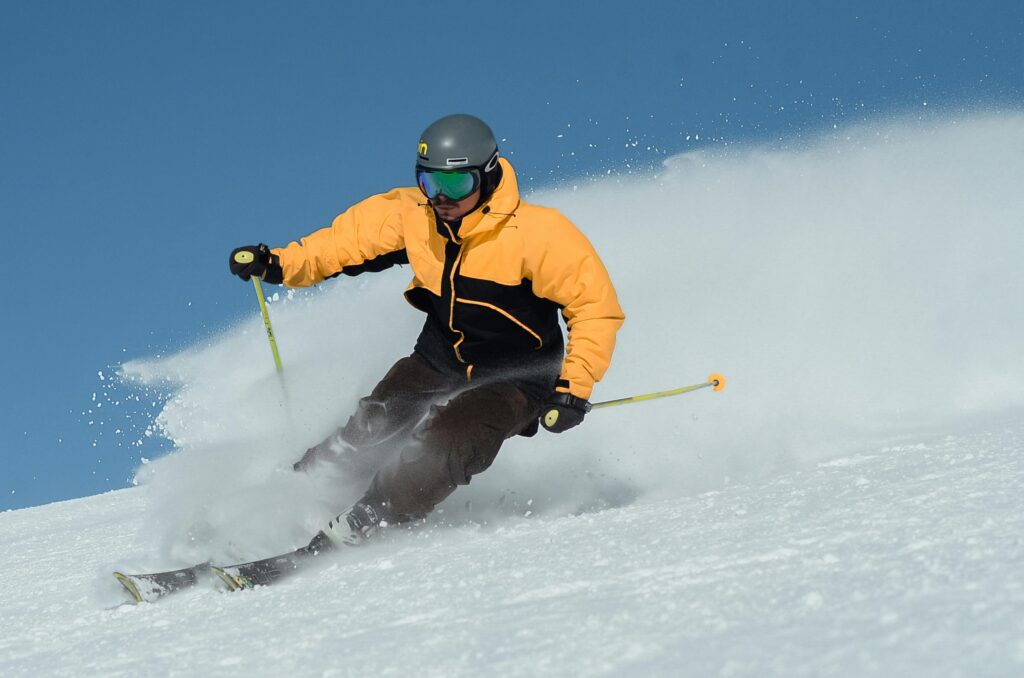
If you want to stop quickly and look like you know what you’re doing, the hockey stop is your best friend. You’ll see advanced skiers using it to come to a sharp halt right next to their friends (sometimes spraying them with snow for fun).
- Pick up a little speed first. You need some momentum so your skis can slide rather than just dig in.
- Turn your skis across the slope. Start by shifting your weight slightly forward and turning both feet at the same time. Your upper body should face slightly downhill while your skis swing across.
- Dig in your edges. Once your skis are sideways, tilt them onto their edges (the inside edges). This is what actually slows you down fast.
- Balance your weight. Don’t lean too far back — that’s a common mistake that makes you fall or slide out. Keep your knees bent, and stay centered over your boots.
- Finish strong. You’ll feel the skis scrape to a stop, usually kicking up a satisfying spray of snow.
It definitely takes a few tries to get the timing right, but once you nail it, you’ll be able to stop on a dime anywhere on the mountain.
Combining Techniques for Versatility
Skiing is all about adapting. Knowing when to switch between stops can save you in tricky spots.
Try mixing these up:
- Snowplow in Tight Spots: Great for crowded areas.
- C-Shaped Turns on Open Runs: Keeps your speed in check with precision.
- Blend Parallel Stance on Steeper Slopes: Adds power and control.
Getting comfortable with these options means you’ll handle whatever the mountain throws at you.
Practice Makes Perfect
Here’s the deal: nothing beats practice.
- Start Easy: Choose gentle slopes to practice.
- Take It Step-by-Step: Nail simple moves like the snowplow before moving on.
- Stay Balanced: Keep knees bent and weight even to stay in control.
Stick with these, and you’ll notice your skills—and confidence—skyrocket.
Mistakes to Avoid While Stopping on Skis
I hope by now you’ve got a good idea of how to stop while skiing. Here are a few common mistakes to watch out for so you can stay safe and confident on the slopes:
1. Leaning back too much
One of the most common errors is leaning backward when trying to stop. When you do this, your skis can slide out from under you, and you lose control. Always try to stay centered over your skis with your weight slightly forward. Think about pressing your shins gently into the front of your boots.
2. Not committing to the stop
A hesitant stop is often a dangerous stop. If you’re unsure or only half-committed, your skis might not edge properly, and you’ll just keep sliding. Once you decide to stop, trust your edges and fully commit to the motion.
3. Keeping skis too close together
When your skis are too close, they can cross, or you may not get enough edge grip. Make sure to keep a comfortable, hip-width stance so you have more stability and control.
4. Looking down at your skis
It’s tempting to stare at your feet, especially when you’re nervous. But looking down throws off your balance and makes it harder to see where you’re going (or what’s coming at you!). Always look ahead in the direction you want to stop.
5. Not using your edges properly
Skis stop by using their edges to dig into the snow, not by just turning sideways and hoping for the best. Beginners sometimes try to “slide” to a stop without enough edge pressure, which rarely works. Focus on angling your skis and pressing into the edges confidently.
6. Stopping in dangerous spots
Even after mastering the stop itself, don’t forget where you’re stopping. Avoid stopping in the middle of a narrow run, just below a hill crest, or right after a turn where others can’t see you. Always move to the side and find a safe, visible spot.
Happy skiing! And if you want a visual guide, these videos can give you an extra hand mastering stops:
Taking the time to master these stopping techniques will seriously boost your control and safety. With a little patience and practice, you’ll be confidently skiing—and stopping—like a pro in no time!
Stopping on skis isn’t just about avoiding spills. It’s about enjoying the ride, feeling smooth, and maybe even showing off a little for your ski buddies. So go ahead—get out there and have fun!


